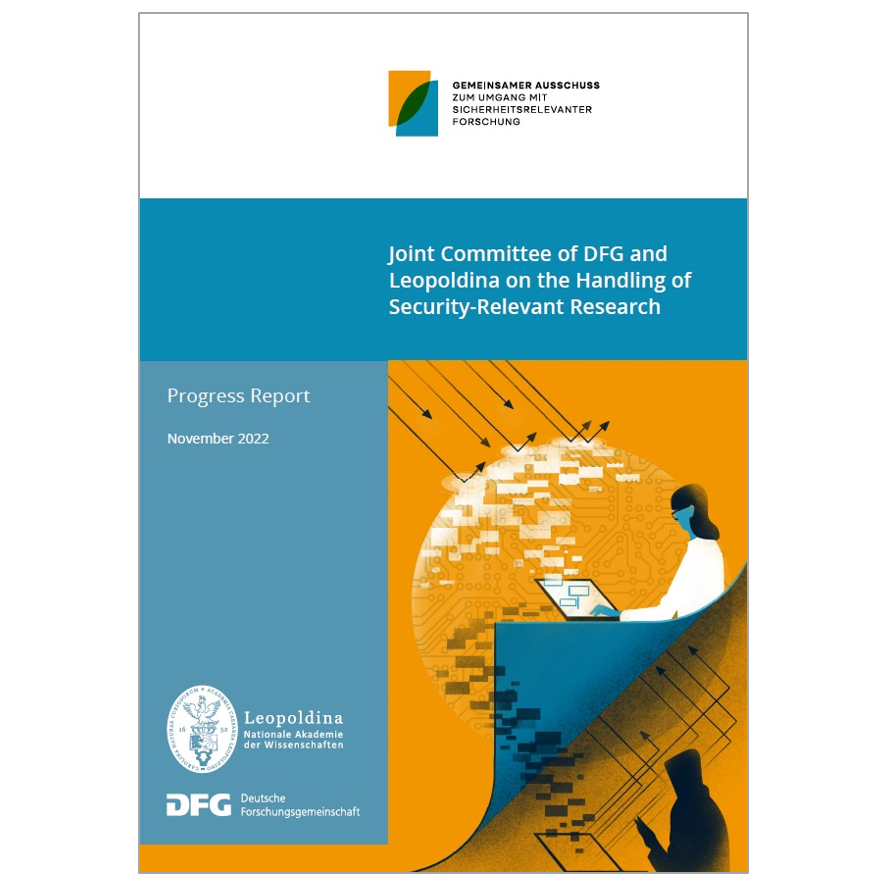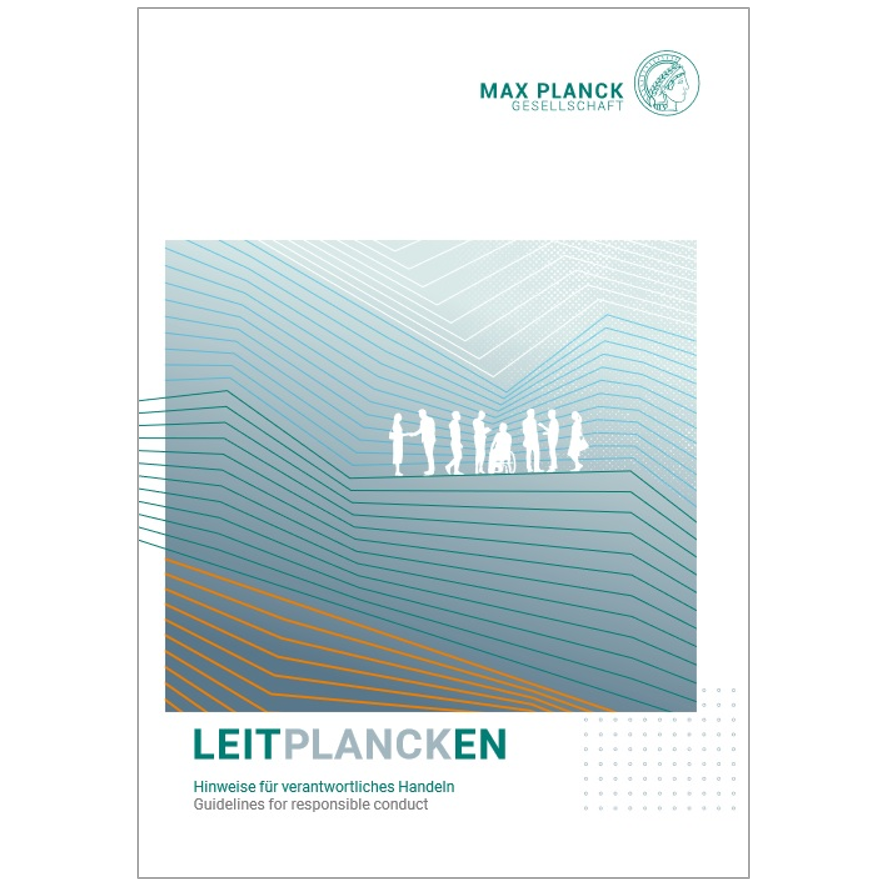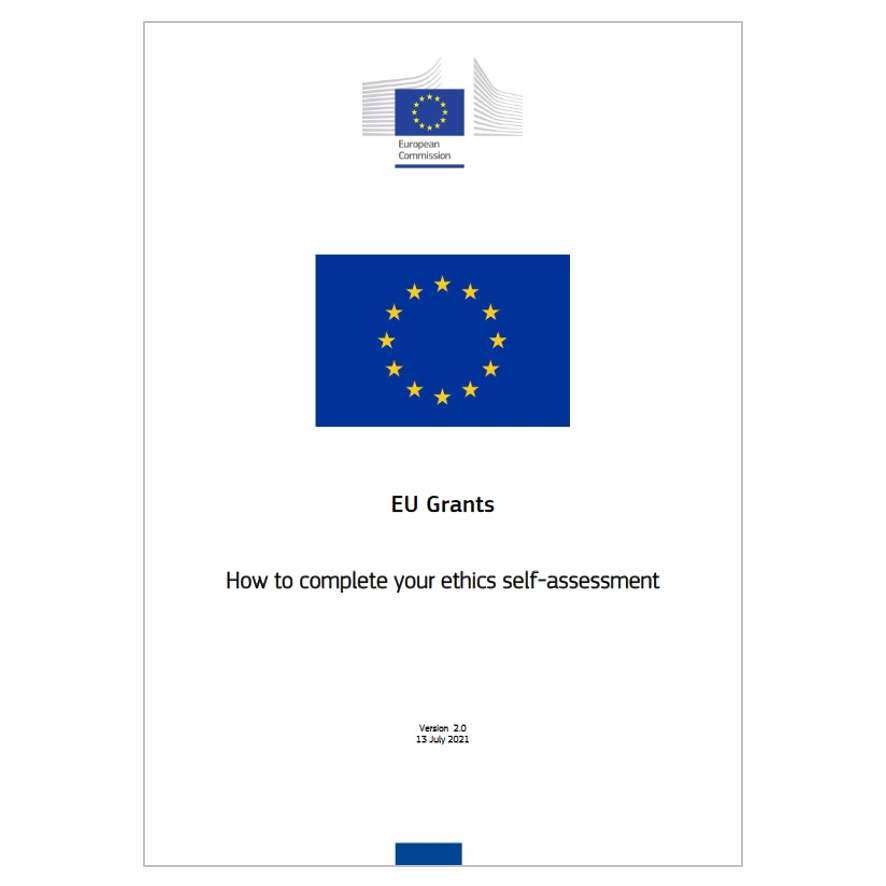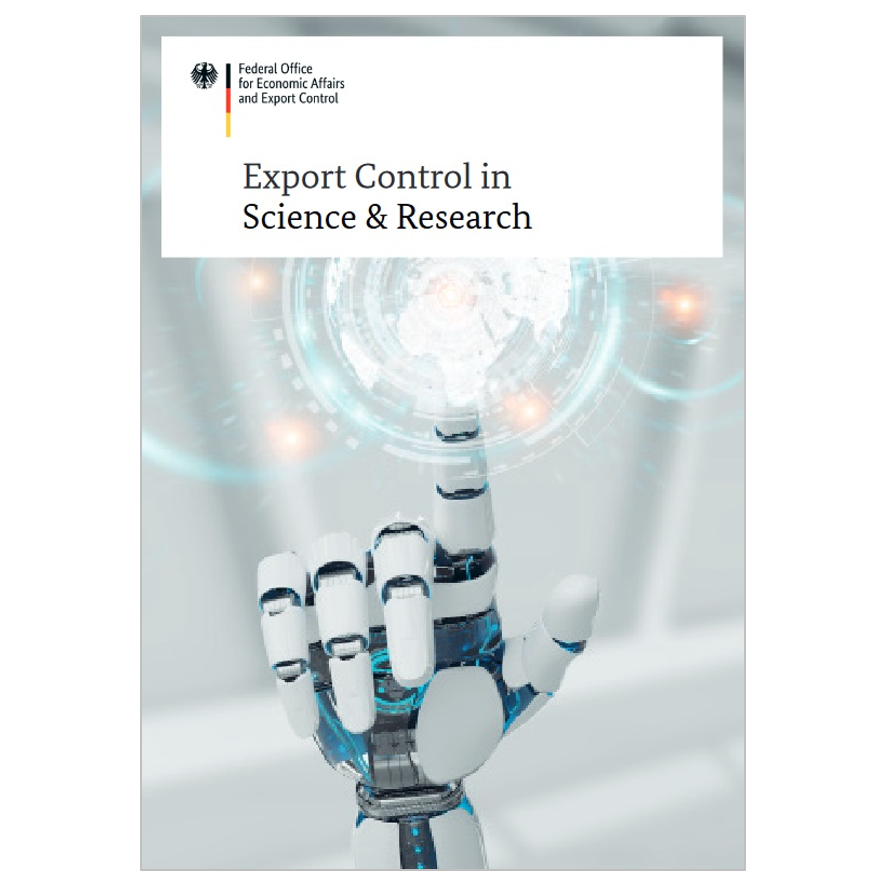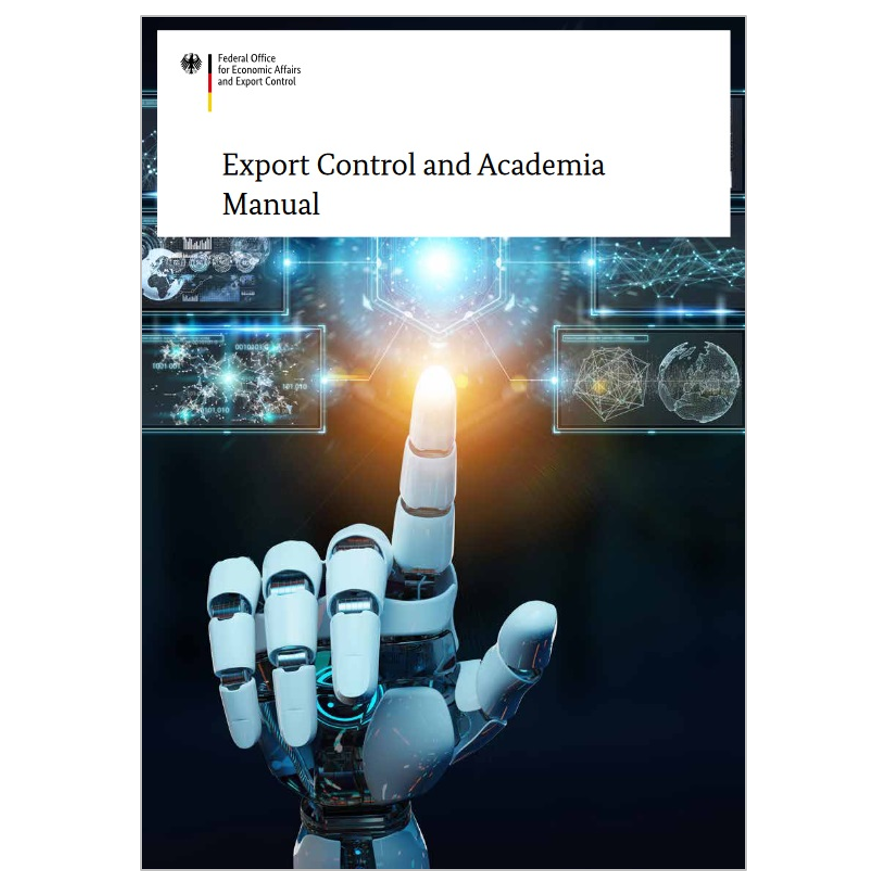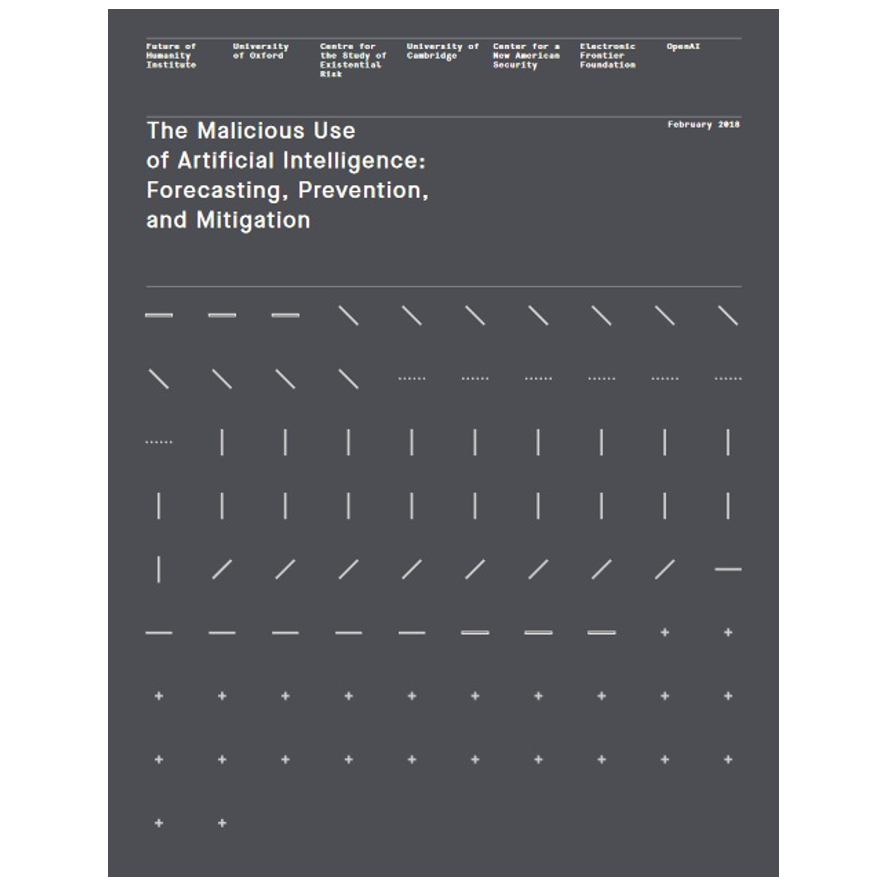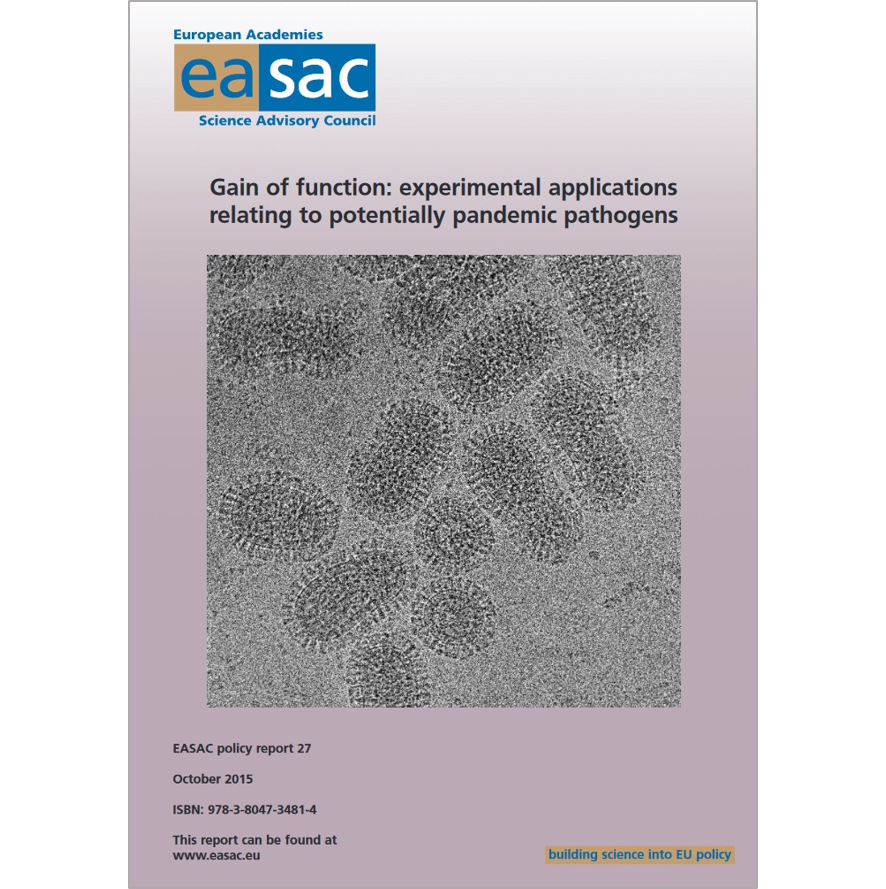Publikationen

-
Startseite
- /
- Publications
Publikationen
-
Applying Ethics in the Handling of Dual Use Research: The Case of Germany
Mehr lesen: Applying Ethics in the Handling of Dual Use Research: The Case of GermanyWith regard to the handling of dual use research, the dominant approach in Germany aimed at mitigating dual use risks emphasizes the freedom of research and the strengthening of academic self-regulation. This article presents this approach as one example for a framework for handling security-relevant research, underlines the need for awareness-raising about risks of security-relevant…
-
Risks in international research cooperation
Mehr lesen: Risks in international research cooperationGuidelines and position statements mention risks arising from international research cooperation. In this analysis, we attempt to decipher the complex challenges in global research partnerships and the intricate web of potential risks in international research. Tables in the appendix of the analysis provide a concrete working aid. Specific risk types, risk indicators and possible measures…
-
Report on Research, Innovation and Technological Performance in Germany
Mehr lesen: Report on Research, Innovation and Technological Performance in GermanyIn view of increasing global threats, the Commission of Experts recommends reevaluating the options for managing military R&D. Studies show that military R&D had positive effects on civilian R&D via spillovers and thereby also positively impacted productivity and employment in the civilian sector in addition to increasing performance in the military sector. To achieve this…
-
A Framework for Tomorrow’s Pathogen Research
Mehr lesen: A Framework for Tomorrow’s Pathogen ResearchThe Bulletin of the Atomic Scientists began more than 75 years ago as an emergency action by scientists who saw an immediate need for a public reckoning in the aftermath of the atomic bombings of Hiroshima and Nagasaki. The scale of the loss of life and the obliteration of these cities in the late summer…
-
G7 Best Practices for Secure and Open Research
Mehr lesen: G7 Best Practices for Secure and Open ResearchOpen and collaborative research allows us to respond to some of the world’s most challenging issues. Research integrity acts as the base from which researchers are able to operate in our global research environment. To support research integrity, the above best practices are meant to help research communities establish and improve processes and efforts to…
-
National security guidelines for research partnerships
Mehr lesen: National security guidelines for research partnershipsThe National Security Guidelines for Research Partnerships integrates national security considerations into the development, evaluation, and funding of research partnerships. The Guidelines better position researchers, research organizations and Government funders to undertake consistent, risk-targeted due diligence of potential risks to research security.
-
Action recommendations for cooperation with China
Mehr lesen: Action recommendations for cooperation with ChinaFor almost 50 years, the Max-Planck-Gesellschaft (MPG) has maintained scientific exchange with the People’s Republic of China (hereinafter referred to as China). With the establishment of official relations withthe Chinese Academy of Sciences (CAS) in 1974, the MPG assumed a pioneering role in the German sciencesystem, has since maintained successful cooperation with many Chinese researchers…
-
The Convergence of Artificial Intelligence and the Life Sciences: Safeguarding Technology, Rethinking Governance, and Preventing Catastrophe
Mehr lesen: The Convergence of Artificial Intelligence and the Life Sciences: Safeguarding Technology, Rethinking Governance, and Preventing CatastropheRapid scientific and technological advances are fueling a 21st-century biotechnology revolution. Accelerating developments in the life sciences and in technologies such as artificial intelligence (AI), automation, and robotics are enhancing scientists’ abilities to engineer living systems for a broad range of purposes. These groundbreaking advances are critical to building a more productive, sustainable, and healthy…
-
Recommendations from the DFG: Dealing with Risks in International Research Cooperation
Mehr lesen: Recommendations from the DFG: Dealing with Risks in International Research CooperationThe potential risks involved in international research cooperation projects funded by the Deutsche Forschungsgemeinschaft (DFG, German Research Foundation) shall henceforth be subjected to a more thorough and systematic reflection. To this end, the largest research funding organisation and central self-governing organisation for science and the humanities in Germany has put forward recommendations that have recently…
-
Stricter US guidelines for ‘gain-of-function’ research are on the way — maybe
Mehr lesen: Stricter US guidelines for ‘gain-of-function’ research are on the way — maybeA biosecurity panel met, expecting to approve recommendations, but myriad concerns complicated the proceedings.
-
Should Democracies Draw Redlines around Research Collaboration with China? A Case Study of Germany.
Mehr lesen: Should Democracies Draw Redlines around Research Collaboration with China? A Case Study of Germany.Global research collaboration in scientific and engineering fields has been critical to advancing the frontiers of knowledge, promoting economic prosper ity, and solving global challenges. The global research enterprise is, by design, largely open and unrestricted. However, new risks and challenges threaten this open collaboration, particularly regarding authoritarian nations like the People’s Republic of China…
-
Scientific Freedom and Scientific Responsibility Recommendations for Handling of Security-Relevant Research
Mehr lesen: Scientific Freedom and Scientific Responsibility Recommendations for Handling of Security-Relevant ResearchResearch plays a fundamental role in ensuring progress. Freedom of research, which is enshrined in the German Basic Law, is a fundamental requirement in this respect. Yet free research is also associated with risks. These risks can only be covered to a limited extent by legal regulations and result primarily from the danger of useful…
-
How National Governments and Research Institutions Safeguard Knowlegde Development in Science and Technology
Mehr lesen: How National Governments and Research Institutions Safeguard Knowlegde Development in Science and TechnologyThe study provides an overview and comparative analysis of nine national approaches to strengthening knowledge security and the forces that drive them. The national approaches are those of Australia, Czech Republic, Finland, France, Germany, Japan, Taiwan, the United Kingdom and the United States. They all have developed different approaches, depending on the national political context,…
-
Progress Report (2022)
Mehr lesen: Progress Report (2022)Aspects of security-relevant research and related ethical issues are increasingly coming into focus, among other things due to advances in research on artificial intelligence and pandemic pathogens, as well as scientific entanglements with states in which human rights violations and other violations of rule-of-law principles are observed. This is reflected in the fourth Progress Report…
-
Guidelines for Researchers on Dual Use and Misuse of Research
Mehr lesen: Guidelines for Researchers on Dual Use and Misuse of ResearchThese Guidelines for Researchers on Dual Use and Misuse of Research have been developed by the five Flemish universities and imec, VIB, the Institute of Tropical Medicine, VITO and FlandersMake. These guidelines describe the expectations and obligations of researchers in research which might be dual use or misused. You may not have heard of these…
-
Information Brochure “The Handling of Security-Relevant Research in Germany – An Overview”
Mehr lesen: Information Brochure “The Handling of Security-Relevant Research in Germany – An Overview”The information brochure is dedicated to the most important questions about dealing with security-related research in Germany. It gives an initial insight into relevant subject areas, the importance and structure of the committes for ethics in security-related research and the legal framework and funding. It describes case studies and illustrates how ethical aspects of security-related research can be anchored…
-
DFG: Proposal Preparation Instructions
Mehr lesen: DFG: Proposal Preparation InstructionsThese guidelines apply to project proposals under the Research Grants, Emmy Noether, Research Units, Clinical Research Units and Priority Programmes. In point 4.1.5, the DFG requests applicants to check their project for security-relevant aspects and to consult a KEF where necessary.
-
LEITPLANCKEN – Guidelines for responsible conduct
Mehr lesen: LEITPLANCKEN – Guidelines for responsible conductFor the Max Planck Society responsible and compliant behaviour is a key basic requirement. It is essential for all employees – both in science and in the science support area – to observe the laws and internal regulations. Responsible behaviour must be based on the structures of our organization, a balanced system which links governance…
-
Annotated collection of guidance for secure and successful international R&I cooperation
Mehr lesen: Annotated collection of guidance for secure and successful international R&I cooperationAn annotated collection of guidelines, checklists and comparable documents is intended as a reference to help stakeholders in research and innovation to safeguard international cooperation.
-
G7 Common Values and Principles on Research Security and Research Integrity
Mehr lesen: G7 Common Values and Principles on Research Security and Research IntegrityThe G7 members envision the continuation of a collaborative research system where the importance of all talent – domestic and international – is acknowledged. Openness and security are not contradictory but complementary and mutually reinforcing. To sustain this vision, we have developed and are embracing these principles of research security, which are common to the…
-
Integrity and security in the global research ecosystem
Mehr lesen: Integrity and security in the global research ecosystemResponsibilities for research integrity and security are distributed across multiple actors in the international research ecosystem. These include, national governments, research funding agencies, research institutions, universities, academic associations, and intergovernmental organisations. This report describes policy initiatives and actions from these different actors to safeguard national and economic security whilst protecting freedom of enquiry, promoting international…
-
Cloud labs: where robots do the research
Mehr lesen: Cloud labs: where robots do the researchA host of companies provide a remote, automated workforce for conducting experiments around the clock.
-
Dual use of artificial-intelligence-powered drug discovery
Mehr lesen: Dual use of artificial-intelligence-powered drug discoveryAn international security conference explored how artificial intelligence (AI) technologies for drug discovery could be misused for de novo design of biochemical weapons. A thought experiment evolved into a computational proof.
-
Tackling R&I foreign interference: Staff working document
Mehr lesen: Tackling R&I foreign interference: Staff working documentThis publication presents the Staff Working Document on tackling R&I foreign interference. Foreign interference occurs when activities are carried out by, or on behalf of, a foreign state-level actor, which are coercive, covert, deceptive, or corrupting and are contrary to the sovereignty, values, and interests of the European Union (EU). EU Higher Education Institutions (HEIs)…
-
National knowledge security guidelines—Secure international collaboration
Mehr lesen: National knowledge security guidelines—Secure international collaborationWorld-class higher education and science cannot exist without internationalcooperation and scientific talent from all over the world. The leading positionand good academic reputation of Dutch knowledge institutions are related tothe academic freedom that is guaranteed in the Netherlands, as well as to theopenness of our knowledge institutions towards the world. Our prosperity is duein large…
-
Brain Computer Interfaces: A New Existential Risk Factor
Mehr lesen: Brain Computer Interfaces: A New Existential Risk FactorThis paper identifies a new existential risk factor that has not been recognised in prior literature: Brain-Computer Interfaces (BCIs). We illustrate how BCI technology could significantly raise the existential risk from global totalitarianism in the near future. In particular this is achieved not just by expansion of surveillance, but the expansion of brain stimulation. At…
-
Commission Recommendation (EU) 2021/1700 on internal compliance programmes for controls of research involving dual-use items under Regulation (EU) 2021/821 of the European Parliament and of the Council setting up a Union regime for the control of exports, brokering, technical assistance, transit and transfer of dual-use items
Mehr lesen: Commission Recommendation (EU) 2021/1700 on internal compliance programmes for controls of research involving dual-use items under Regulation (EU) 2021/821 of the European Parliament and of the Council setting up a Union regime for the control of exports, brokering, technical assistance, transit and transfer of dual-use items -
The origins of SARS-CoV-2: A critical review
Mehr lesen: The origins of SARS-CoV-2: A critical reviewSince the first reports of a novel severe acute respiratory syndrome (SARS)-like coronavirus in December 2019 in Wuhan, China, there has been intense interest in understanding how severe acute respiratory syndrome coronavirus 2 (SARS-CoV-2) emerged in the human population. Recent debate has coalesced around two competing ideas: a “laboratory escape” scenario and zoonotic emergence. Here,…
-
EU Grants: How to complete your ethics self-assessment: V2.0
Mehr lesen: EU Grants: How to complete your ethics self-assessment: V2.0The EU Framework Programme for Research and Innovation “Horizon Europe” requires funding proposals to include an ethics self-assessment of the potential risks of misuse of the research project that could pose a threat to human beings, animals and the environment. The European Commission has published accompanying guidelines for completing the assessment. Amongst other things, the…
-
The Tianjin Biosecurity Guidelines for Codes of Conduct for Scientists
Mehr lesen: The Tianjin Biosecurity Guidelines for Codes of Conduct for ScientistsAdvances in the biological sciences bring about wellbeing for humanity, but the same advances could be misused, particularly for the development and proliferation of biological weapons. To promote a culture of responsibility and guard against such misuse, all scientists, research institutions, and governments are encouraged to incorporate elements from the Tianjin Biosecurity Guidelines for Codes…
-
Cybercrime vs. Cyberwar: Paradigms for Addressing Malicious Cyber Activity
Mehr lesen: Cybercrime vs. Cyberwar: Paradigms for Addressing Malicious Cyber ActivityAlthough acts of cybercrime and cyberwar are different, the lines between the two have been become blurred over time. The nature of cyberspace has complicated the pre-existing doctrine for armed attacks, yet they are still being applied. Furthermore, the United States historically has responded to malicious cyber activity through a militarized lens. This tendency to…
-
Proposal for a Regulation of the European Parliament and the Council laying down harmonised rules on artificial intelligence and amending certain Union legislative acts
Mehr lesen: Proposal for a Regulation of the European Parliament and the Council laying down harmonised rules on artificial intelligence and amending certain Union legislative acts -
Guidelines for the development of international collaborations of the Max-Planck-Gesellschaft
Mehr lesen: Guidelines for the development of international collaborations of the Max-Planck-GesellschaftThe “Guidelines for the Development of International Cooperations of the Max Planck Society” serve to support scientists of the Max Planck Society in in balancing freedom of research, rule compliance and individual responsibility so that they are able to successfully carry out international collaborations even under uncertain or challenging conditions.
-
A Code of Ethics for Gene Drive Research
Mehr lesen: A Code of Ethics for Gene Drive ResearchGene drives hold promise for use in controlling insect vectors of diseases, agricultural pests, and for conservation of ecosystems against invasive species. At the same time, this technology comes with potential risks that include unknown downstream effects on entire ecosystems as well as the accidental or nefarious spread of organisms that carry the gene drive…
-
Checklist for Collaboration with Chinese Universities and Other Research Institutions
Mehr lesen: Checklist for Collaboration with Chinese Universities and Other Research InstitutionsThe Hague Centre for Strategic Studies (HCSS) has worked in close cooperation with the Leiden Asia Centre (LAC) on an extensive study mapping the risks and challenges of academic and research collaboration with Chinese partners. To this end, the LAC and HCSS conducted over 40 interviews with scientists and university staff in the Netherlands and…
-
Internet, the great radicalizer? Exploring relationships between seeking for online extremist materials and cognitive radicalization in young adults
Mehr lesen: Internet, the great radicalizer? Exploring relationships between seeking for online extremist materials and cognitive radicalization in young adultsAnecdotal evidence asserts that extremist materials on the internet play a decisive role in radicalization processes. However, due to a structural absence of empirical data in the current literature, it remains uncertain if—and to what extent—online extremist materials radicalize. Therefore, the approach of the current study was two-fold. First, we explored what types of online…
-
Responsible internationalisation: Guidelines for reflection on international academic collaboration
Mehr lesen: Responsible internationalisation: Guidelines for reflection on international academic collaborationInternationalisation generally generates value for research and higher education. Overall, internationalisation of research aims to enhance quality and improvethe dissemination of results. Yet internationalisation needs to be pursued responsibly. Researchers, support services and HEI management need to assess the challengesand opportunities related to international collaboration. This need is particularlypertinent in cases of cooperation with partners…
-
Progress Report (2020)
Mehr lesen: Progress Report (2020)The compliance with ethical principles in security-relevant research receives internationally increasing attention. In particular, aspects of export control and research cooperation with foreign partners are in the focus of German politics and research funding. Security-relevant research risks continue to develop dynamically, for example through new synergies of different disciplines such as research on artificial intelligence,…
-
Key questions for the ethical assessment of security-relevant research
Mehr lesen: Key questions for the ethical assessment of security-relevant researchThe key questions were compiled by the Joint Committee on the Handling of Security-Relevant Research based on the KEFs’ feedback on their work from 2016–2019, published checklists and guidelines on research risks. The Joint Committee believes that the respective responses of researchers and KEFs and the consequences derived from them for the work in question…
-
Risky Business – Rethinking Research Cooperation and Exchange with Non-Democracies
Mehr lesen: Risky Business – Rethinking Research Cooperation and Exchange with Non-DemocraciesStrategies for Foundations, Universities, Civil Society Organizations, and Think Tanks.
-
Rapid reconstruction of SARS-CoV-2 using a synthetic genomics platform
Mehr lesen: Rapid reconstruction of SARS-CoV-2 using a synthetic genomics platformReverse genetics has been an indispensable tool to gain insights into viral pathogenesis and vaccine development. The genomes of large RNA viruses, such as those from coronaviruses, are cumbersome to clone and manipulate in Escherichia coli owing to the size and occasional instability of the genome. Therefore, an alternative rapid and robust reverse-genetics platform for…
-
Crossing Boundaries in Science: The Mystery of Risks – How Can Science Help Reconcile Perception and Assessment?
Mehr lesen: Crossing Boundaries in Science: The Mystery of Risks – How Can Science Help Reconcile Perception and Assessment?The conference format ‘Crossing Boundaries in Science’ of the German National Academy of Sciences Leopoldina is meant to stimulate discussions between areas of research that are particularly dependent on new forms of interdisciplinary cooperation and method transfer. The first international conference, entitled ‘Modelling Nature and Society – Can We Control the World?’ took place in…
-
Wired Emotions: Ethical Issues of Affective Brain–Computer Interfaces
Mehr lesen: Wired Emotions: Ethical Issues of Affective Brain–Computer InterfacesEthical issues concerning brain–computer interfaces (BCIs) have already received a considerable amount of attention. However, one particular form of BCI has not received the attention that it deserves: Affective BCIs that allow for the detection and stimulation of affective states. This paper brings the ethical issues of affective BCIs in sharper focus. The paper briefly…
-
The China Defence Universities Tracker: Exploring the military and security links of China’s universities
Mehr lesen: The China Defence Universities Tracker: Exploring the military and security links of China’s universitiesThe Chinese Communist Party (CCP) is building links between China’s civilian universities, military and security agencies. Those efforts, carried out under a policy of leveraging the civilian sector to maximise military power (known as ‘military–civil fusion’), have accelerated in the past decade. Research for the China Defence Universities Tracker has determined that greater numbers of…
-
DFG-Code “Guidelines for Safeguarding Good Research Practice“
Mehr lesen: DFG-Code “Guidelines for Safeguarding Good Research Practice“The aim of the Code of the German Research Foundation (DFG, Deutsche Forschungsgemeinschaft) is to enable the intended audience – researchers as well as heads of universities and non-university research institutions – to align their internal structures, processes and actions with the guidelines for good research practice. The intention is to create a deeply rooted…
-
Ethics committees in security-relevant research according to the recommendations of Leopoldina and the German Research Foundation
Mehr lesen: Ethics committees in security-relevant research according to the recommendations of Leopoldina and the German Research FoundationThe scientific freedom protected by the German Basic Law is a prerequisite for the progress and prosperity of society. However, free research is also associated with risks resulting from the fact that useful research results and methods can be abused, for example as weapons of war or as a means of criminal or terrorist activities. According…
-
Resisting Chinese Government Efforts to Undermine Academic Freedom Abroad – A Code of Conduct for Colleges, Universities, and Academic Institutions Worldwide
Mehr lesen: Resisting Chinese Government Efforts to Undermine Academic Freedom Abroad – A Code of Conduct for Colleges, Universities, and Academic Institutions WorldwideHuman Rights Watch investigations found that the Chinese government attempts to restrict academic freedom beyond its borders. To counter such pressures, ensure the integrity of academic institutions, and protect the academic freedom and free expression rights of students, scholars, and administrators, particularly those who work on China or are from China, Human Rights Watch proposes…
-
Export Control in Science & Research
Mehr lesen: Export Control in Science & ResearchThis publication is aimed at professors, scientists and scientific staff at universities and non-university research institutions as well as representatives of these organizations working in the field of “export control and research activities“. It deals, in particular, with the rights and obligations that apply in this area. While scientific freedom is enshrined in the Basic…
-
Export Control and Academia Manual
Mehr lesen: Export Control and Academia ManualThis Manual is primarily aimed at the academic and research sector, its representatives and employees as well as scientists as private individuals. The goal is to raise the awareness of universities and research institutions for the aims of export control and to support them in the application of foreign trade law. Restrictions under foreign trade…
-
Governance of Dual Use Research in the Life Sciences: Advancing Global Consensus on Research Oversight: Proceedings of a Workshop
Mehr lesen: Governance of Dual Use Research in the Life Sciences: Advancing Global Consensus on Research Oversight: Proceedings of a WorkshopContinuing advances in science and technology offer the promise of providing tools to meet global challenges in health, agriculture, the environment, and economic development; some of the benefits are already being realized. However, such advances have the potential to challenge the oversight systems for responsible conduct of life sciences research with dual use potential –…
-
Picking flowers, making honey: The Chinese military’s collaboration with foreign universities
Mehr lesen: Picking flowers, making honey: The Chinese military’s collaboration with foreign universitiesChina’s People’s Liberation Army’s (PLA) collaboration with foreign universities is growing and the expansion of international ties remains one of the priorities of the PLA National University of Defense Technology (NUDT). The developments outlined in this report warrant more attention and different approaches from those currently employed by most governments and universities. Responses to PLA…
-
Agricultural research, or a new bioweapon system?
Mehr lesen: Agricultural research, or a new bioweapon system?Agricultural genetic technologies typically achieve their agronomic aims by introducing laboratory-generated modifications into target species’ chromosomes. However, the speed and flexibility of this approach are limited, because modified chromosomes must be vertically inherited from one generation to the next. In an effort to remove this limitation, an ongoing research program funded by the U.S. Defense…
-
Progress Report (2018)
Mehr lesen: Progress Report (2018)The report presents current debates and developments in the field of security-relevant research (Chapters A 2 & A 4). Furthermore, the framework conditions for the funding of security-relevant research by the DFG and the EU Framework Programme for Research and Innovation Horizon 2020 are discussed (Chapter A 4). In addition, the status and specific strategies…
-
Biodefense in the Age of Synthetic Biology
Mehr lesen: Biodefense in the Age of Synthetic BiologyScientific advances over the past several decades have accelerated the ability to engineer existing organisms and to potentially create novel ones not found in nature. Synthetic biology, which collectively refers to concepts, approaches, and tools that enable the modification or creation of biological organisms, is being pursued overwhelmingly for beneficial purposes ranging from reducing the…
-
THIS IS HOW WE WORK TOWARDS A BETTER FUTURE – TNO CODE OF CONDUCT
Mehr lesen: THIS IS HOW WE WORK TOWARDS A BETTER FUTURE – TNO CODE OF CONDUCTTNO brings together people and expertise in order to create innovations. This enables us to make businesses more competitive and to contribute to a sustainable and healthy society. We set ourselves high standards in terms of conducting independent research, innovation and contributing to economic growth. Our professionals use their expertise, inspiration and customer focus to…
-
Statement on artificial intelligence, robotics and ‘autonomous’ systems
Mehr lesen: Statement on artificial intelligence, robotics and ‘autonomous’ systemsAdvances in AI, robotics and so-called ‘autonomous’ technologies¹ have ushered in a range of increasingly urgent and complex moral questions. Current efforts to find answers to the ethical, societal and legal challenges that they pose and to orient them for the common good represent a patchwork of disparate initiatives. This underlines the need for a…
-
The Malicious Use of Artificial Intelligence: Forecasting, Prevention, and Mitigation
Mehr lesen: The Malicious Use of Artificial Intelligence: Forecasting, Prevention, and MitigationArtificial intelligence and machine learning capabilities are growing at an unprecedented rate. These technologies have many widely beneficial applications, ranging from machine translation to medical image analysis. Countless more such applications are being developed and can be expected over the long term. Less attention has historically been paid to the ways in which artificial intelligence…
-
Deep neural networks are more accurate than humans at detecting sexual orientation from facial images.
Mehr lesen: Deep neural networks are more accurate than humans at detecting sexual orientation from facial images.We show that faces contain much more information about sexual orientation than can be perceived or interpreted by the human brain. We used deep neural networks to extract features from 35,326 facial images. These features were entered into a logistic regression aimed at classifying sexual orientation. Given a single facial image, a classifier could correctly…
-
Construction of an infectious horsepox virus vaccine from chemically synthesized DNA fragments
Mehr lesen: Construction of an infectious horsepox virus vaccine from chemically synthesized DNA fragmentsEdward Jenner and his contemporaries believed that his variolae vaccinae originated in horses and molecular analyses show that modern vaccinia virus (VACV) strains share common ancestry with horsepox virus (HPXV). Given concerns relating to the toxicity of modern VACV vaccines, we asked whether an HPXV-based vaccine might provide a superior alternative. Since HPXV may be…
-
Four ethical priorities for neurotechnologies and AI
Mehr lesen: Four ethical priorities for neurotechnologies and AIArtificial intelligence and brain–computer interfaces must respect and preserve people’s privacy, identity, agency and equality, say Rafael Yuste, Sara Goering and colleagues.
-
Assessing the Security Implications of Genome Editing Technology – Report of an international workshop
Mehr lesen: Assessing the Security Implications of Genome Editing Technology – Report of an international workshopFrom 11 to 13 October 2017, the InterAcademy Partnership (IAP) held a workshop on the latest advances in genome editing and their societal implications. The workshop was organised by the US National Academies of Science, Engineering and Medicine (NASEM), the European Academies Science Advisory Council (EASAC) and Leopoldina.
-
Digital-to-biological converter for on-demand production of biologics
Mehr lesen: Digital-to-biological converter for on-demand production of biologicsManufacturing processes for biological molecules in the research laboratory have failed to keep pace with the rapid advances in automization and parellelization. We report the development of a digital-to-biological converter for fully automated, versatile and demand-based production of functional biologics starting from DNA sequence information. Specifically, DNA templates, RNA molecules, proteins and viral particles were…
-
Dual Use Research of Concern in the Life Sciences: Current Issues and Controversies
Mehr lesen: Dual Use Research of Concern in the Life Sciences: Current Issues and ControversiesThe potential misuse of advances in life sciences research is raising concerns about national security threats. “Dual Use Research of Concern in the Life Sciences: Current Issues and Controversies” examines the U.S. strategy for reducing biosecurity risks in life sciences research and considers mechanisms that would allow researchers to manage the dissemination of the results…
-
Progress Report (2016)
Mehr lesen: Progress Report (2016)This progress report begins with a summary in Chapter A of the developments leading up to the establishment of the Joint Committee on the Handling of Security-Relevant Research by the Deutsche Forschungsgemeinschaft (DFG, German Research Foundation) and the German National Academy of Sciences Leopoldina in November 2014. Chapter B reports on the tasks of the…
-
A Proliferation Assessment of Third Generation Laser Uranium Enrichment Technology
Mehr lesen: A Proliferation Assessment of Third Generation Laser Uranium Enrichment TechnologyLong-standing efforts to develop a commercially viable laser-based process for uranium enrichment, initially with atomic and later molecular isotope separation, have had limited success. This article discusses a model for a third generation of laser enrichment technology where CO2 laser light is Raman scattered to generate 16 μm photons that excite a vibrational mode in…
-
Model Statutes for Committees for Ethics in Security-Relevant Research
Mehr lesen: Model Statutes for Committees for Ethics in Security-Relevant ResearchThe model statutes are designed to provide assistance in establishing KEFs (Committees for Ethics in Security-Relevant Research) at German universities, research institutes and research associations.
-
The Hague Ethical Guidelines
Mehr lesen: The Hague Ethical GuidelinesTo promote a culture of responsible conduct in the chemical sciences and to guard against the misuse of chemistry, a group of chemical practitioners from around the world have formulated a set of ethical guidelines informed by the Chemical Weapons Convention – The Hague Ethical Guidelines.
-
Engineered bat virus stirs debate over risky research
Mehr lesen: Engineered bat virus stirs debate over risky researchAn experiment that created a hybrid version of a bat coronavirus — one related to the virus that causes SARS (severe acute respiratory syndrome) — has triggered renewed debate over whether engineering lab variants of viruses with possible pandemic potential is worth the risks.
-
A SARS-like cluster of circulating bat coronaviruses shows potential for human emergence
Mehr lesen: A SARS-like cluster of circulating bat coronaviruses shows potential for human emergenceThe emergence of severe acute respiratory syndrome coronavirus (SARS-CoV) and Middle East respiratory syndrome (MERS)-CoV underscores the threat of cross-species transmission events leading to outbreaks in humans. Here we examine the disease potential of a SARS-like virus, SHC014-CoV, which is currently circulating in Chinese horseshoe bat populations1. Using the SARS-CoV reverse genetics system2, we generated…
-
Gain of Function: experimental applications relating to potentially pandemic pathogens
Mehr lesen: Gain of Function: experimental applications relating to potentially pandemic pathogensInfluenza outbreaks cause significant burden to public health. The inability to predict which specific virus subtypes will trigger the next influenza pandemic emphasizes the need to address gaps in the knowledge required to manage future pandemics. Research, including the study of virus transmissibility, host range, resistance, immunogenicity, pathogenicity and virulence, is critical to fill many…
-
The opportunities and limits of genome editing
Mehr lesen: The opportunities and limits of genome editingJoint Statement of the German Research Foundation, the National Academy of Sciences Leopoldina, acatech – National Academy of Science and Engineering, and the Union of the German Academies of Sciences and Humanities. Modern molecular techniques often referred to as “genome editing” or “genome surgery” are currently revolutionising molecular biology research. Technologies such as CRISPR-Cas9 allow…
-
Scientific Freedom and Scientific Responsibility (2014): Recommendations for Handling Security-Relevant Research
Mehr lesen: Scientific Freedom and Scientific Responsibility (2014): Recommendations for Handling Security-Relevant Research1st version, updated 2022. Research plays a fundamental role in ensuring progress. Freedom of research, which is enshrined in the German Basic Law, is a fundamental requirement in this respect. Yet free research is also associated with risks. These risks result primarily from the danger of useful research findings being misused (known as the dual…
-
Biosecurity — Freedom and Responsibility of Research: Opinion
Mehr lesen: Biosecurity — Freedom and Responsibility of Research: OpinionSome research results obtained in the life sciences can be used not only for the benefit of individuals and society as a whole, but also misused with intent to cause harm. Research such as this is referred to as Dual Use Research of Concern (DURC). To counteract such misuse proactively the German Ethics Council advocates…
-
Experimental Adaptation of Wild-Type Canine Distemper Virus (CDV) to the Human Entry Receptor CD150
Mehr lesen: Experimental Adaptation of Wild-Type Canine Distemper Virus (CDV) to the Human Entry Receptor CD150Canine distemper virus (CDV), a close relative of measles virus (MV), is widespread and well known for its broad host range. When the goal of measles eradication may be achieved, and when measles vaccination will be stopped, CDV might eventually cross the species barrier to humans and emerge as a new human pathogen. In order…
-
The Menlo Report: Ethical Principles Guiding Information and Communication Technology Research
Mehr lesen: The Menlo Report: Ethical Principles Guiding Information and Communication Technology ResearchThis report proposes a framework for ethical guidelines for computer and information security research, based on the principles set forth in the 1979 Belmont Report, a seminal guide for ethical research in the biomedical and behavioral sciences. Despite its age, the Belmont Report’s insightful abstraction renders it a valuable cornerstone for other domains. We describe…
-
Airborne Transmission of Influenza A/H5N1 Virus Between Ferrets
Mehr lesen: Airborne Transmission of Influenza A/H5N1 Virus Between FerretsHighly pathogenic avian influenza A/H5N1 virus can cause morbidity and mortality in humans but thus far has not acquired the ability to be transmitted by aerosol or respiratory droplet (“airborne transmission”) between humans. To address the concern that the virus could acquire this ability under natural conditions, we genetically modified A/H5N1 virus by site-directed mutagenesis…
-
Experimental adaptation of an influenza H5 HA confers respiratory droplet transmission to a reassortant H5 HA/H1N1 virus in ferrets
Mehr lesen: Experimental adaptation of an influenza H5 HA confers respiratory droplet transmission to a reassortant H5 HA/H1N1 virus in ferretsHighly pathogenic avian H5N1 influenza A viruses occasionally infect humans, but currently do not transmit efficiently among humans. The viral haemagglutinin (HA) protein is a known host-range determinant as it mediates virus binding to host-specific cellular receptors. Here we assess the molecular changes in HA that would allow a virus possessing subtype H5 HA to…
-
On the Feasibility of Side-Channel Attacks with Brain-Computer Interfaces
Mehr lesen: On the Feasibility of Side-Channel Attacks with Brain-Computer InterfacesBrain computer interfaces (BCI) are becoming increasingly popular in the gaming and entertainment industries. Consumer-grade BCI devices are available for a few hundred dollars and are used in a variety of applications, such as video games, hands-free keyboards, or as an assistant in relaxation training. There are application stores similar to the ones used for…
-
Challenges and Opportunities for Education About Dual Use Issues in the Life Sciences
Mehr lesen: Challenges and Opportunities for Education About Dual Use Issues in the Life SciencesThe Challenges and Opportunities for Education About Dual Use Issues in the Life Sciences workshop was held to engage the life sciences community on the particular security issues related to research with dual use potential. More than 60 participants from almost 30 countries took part and included practicing life scientists, bioethics and biosecurity practitioners, and…
-
Characterization of the Reconstructed 1918 Spanish Influenza Pandemic Virus
Mehr lesen: Characterization of the Reconstructed 1918 Spanish Influenza Pandemic VirusThe pandemic influenza virus of 1918–1919 killed an estimated 20 to 50 million people worldwide. With the recent availability of the complete 1918 influenza virus coding sequence, we used reverse genetics to generate an influenza virus bearing all eight gene segments of the pandemic virus to study the properties associated with its extraordinary virulence. In…
-
Chemical Synthesis of Poliovirus cDNA: Generation of Infectious Virus in the Absence of Natural Template
Mehr lesen: Chemical Synthesis of Poliovirus cDNA: Generation of Infectious Virus in the Absence of Natural TemplateFull-length poliovirus complementary DNA (cDNA) was synthesized by assembling oligonucleotides of plus and minus strand polarity. The synthetic poliovirus cDNA was transcribed by RNA polymerase into viral RNA, which translated and replicated in a cell-free extract, resulting in the de novo synthesis of infectious poliovirus. Experiments in tissue culture using neutralizing antibodies and CD155 receptor–specific…
-
Variola virus immune evasion design: Expression of a highly efficient inhibitor of human complement
Mehr lesen: Variola virus immune evasion design: Expression of a highly efficient inhibitor of human complementVariola virus, the most virulent member of the genus Orthopoxvirus, specifically infects humans and has no other animal reservoir. Variola causes the contagious disease smallpox, which has a 30–40% mortality rate. Conversely, the prototype orthopoxvirus, vaccinia, causes no disease in immunocompetent humans and was used in the global eradication of smallpox, which ended in 1977.…
-
Chemical Weapons Convention
Mehr lesen: Chemical Weapons ConventionThe Chemical Weapons Convention (CWC) of 13 January 1993 entered into force on 29 April 1997. It is an international disarmament and arms control treaty whose objectives are a worldwide ban on chemical weapons and the destruction of existing chemical weapons stockpiles. The CWC is divided into a military part and a civil part. Thus,…
-
Biological Weapons Convention
Mehr lesen: Biological Weapons ConventionThe Convention on the Prohibition of the Development, Production and Stockpiling of Bacteriological (Biological) and Toxin Weapons and on their Destruction (BWC) of 10 April 1972 entered into force on 26 March 1975. It contains a comprehensive ban on biological weapons and, as the first multilateral treaty to outlaw one type of weapon in its…






